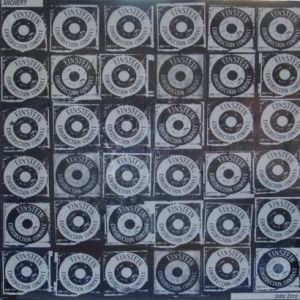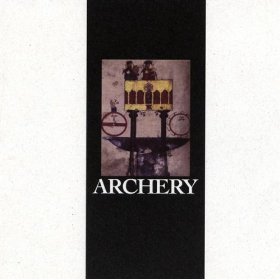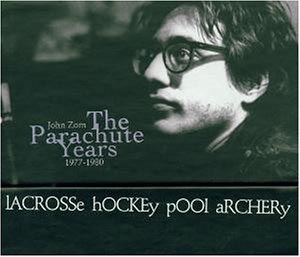JOHN ZORN






Disc five: ARCHERY REHEARSAL
1/ Part 1 (Zorn) 32.10
2/ Part 2 (Zorn) 16.14
3/ Part 3 (Zorn) 28.32
Disc six: ARCHERY
1/ A1 - D2 (Zorn) 20.35
2/ D3 - G1 (Zorn) 20.07
Disc seven: ARCHERY
1/ G2 - L4 (Zorn) 23.53
2/ L5 - O14 (Zorn) 23.29
Recorded at OAO Studio, Brooklyn, New York, September 9,10,12 & 13, 1981
Engineered by Martin Bisis and Michael Lytle
Stereo layout and live two-track mix by Michael Lytle
Produced by John Zorn
Mastered by Howie Weinberg (Masterdisk)
Robert Dick: flute, bass flute, piccolo, game calls; George Lewis: tenor trombone;
John Zorn: alto, soprano, Bb and Eb clarinets, game calls; Anthony G. Coleman:
Yamaha organ, electric piano, obsolete mutron, Big Muff; Wayne B. Horvitz: Farfisa
organ, harmonica, tape, electronics; Mark Kramer: cheap organ, tapes, synthesizer,
radio, BeeGees rhythm machine, devices; Eugene Chadbourne: Epiphone and
George Burns electric guitars, Gibson acoustic, Champ and Traynor amps, personal
effects; Bill Horvitz : electric guitar; Bill Laswell: 4 and 6 string Fender basses;
Polly Bradfield: violin; Tom Cora: cello; David Moss: drums, voice, wood, water,
cymbals, metal pieces, pods, steel drum, zither, hammered dulcimer, Bertoia sound
sculptures, toys, mylar; Mark Smith : prompter.
1981 - Parachute Records (USA), P017/18 (2x12")
1997 - Tzadik (USA), TZ 7316-4 (7CD)
2001 - Tzadik (USA), TZ7316 (3CD)
Note: The original vinyl does not contain the rehearsal tracks recorded on September 9 & 10.
Ah, but what does it sound like? Sometimes it sounds "musical," whatever that means. Mostly, it does not. It sounds like a game, it sounds like people eagerly willing to paste their own creativity onto a graphically notated score that doesn't tell them what to play, just how much time they have and in what combinations they must work together in order for the work to be finished. Chaos? Nah. More like mischief and exploratory hooliganism. Zorn's anarchic democracy creates possibilities not just for sound and solo that were heretofore unrealized, but, as evidenced by the extra CD included of the piece's rehearsal, could never exist again. To listen through both CDs of the recorded work is to encounter a work of timeless humor and grand vision. For Zorn proved more than the sum of his many influences, as early as 1979 when he composed this work he was an original. This is cartoon soundtrack music, but the cartoon is Western musical history as it falls in on itself while trying not to lose its tuxedo. This is musical and cultural terrorism with a smart-ass grin on its face as the opposition puzzles bemusedly before being murdered in its sleep. "Archery" then goes straight to the heart of all people once held sacred and reorganizes it to look like reality. The package, as with all Tzadik releases, is stellar, full of three inserts, production notes, and a replica of the original score. If you allow it to, it will change the way you listen to music — and maybe watch TV, too.
Thom Jurek (courtesy of the All Music Guide website)
AMG EXPERT REVIEW: The Parachute Years is a box of seven CDs from John Zorn's first self-produced recordings. Included are his systems of structure for improvisation which he developed based on game systems, namely Lacrosse, Hockey, Pool, and Archery, as well as over two hours of previously unreleased material (outtakes, rehearsals, etc.). Zorn first began developing his game-based ideas -- which focused on relations between individual musicians, rather than on notes -- in 1974, inspired by the works of such modern composers as Anthony Braxton, Mauricio Kagel, Karlheinz Stockhausen, and Christian Wolff. Presented first is a double disc's worth of Lacrosse performances. The first disc, from June, 1978 at WKCR in NYC, offers six takes on the piece, performed by Zorn, Mark Abbott, Polly Bradfield, Eugene Chadbourne, and LaDonna Smith, all ranging from six to 20 minutes in length. The second disc presents the original recording of Lacrosse which took place one year earlier in San Francisco. The musicians involved in this, John Zorn's first recorded work, are Chadbourne, Henry Kaiser, Bruce Ackley, and Zorn -- a lineup dubbed Twins. Next comes a single disc of Hockey, an improv structure that was completed and first performed in March, 1978 by 300 Statues, the name for the trio of Chadbourne, Bradfield, and Zorn; however, their version is not heard here. Instead, two other lineups' interpretations are heard: the first offers four electric takes (also recorded in 1978) by Chadbourne, Wayne Horvitz, and Bob Ostertag; these are followed by the second lineup's 13 acoustic interpretations, as performed by Bradfield, Zorn, and Mark E. Miller. Pool was written in March, 1979 while Zorn was working on Archery. The recording included here took place one year later with musicians Zorn, Bradfield, Ostertag, Miller, and Charles K. Noyes, and prompter Lesli Dalaba. The three CDs of Archery (one of which is all rehearsals) document a 12-piece ensemble organized in 1981: Robert Dick, George Lewis, Anthony Coleman, Kramer, Bill Laswell, Tom Cora, David Moss, Wayne and Bill Horvitz, Chadbourne, Bradfield, and Zorn. The structure of Pool, and the ways in which it differs from Archery, are matters of compositional theory that cannot be distilled into a review's format. This box set is for those already intrigued by Zorn's ideas; dedicated fans should check this out, as it is the early annals of Zorn. Listeners with less patience for theory (or history), however -- and Zorn skeptics -- should definitely avoid the Parachute Years, for these releases are not going to win anyone over; nor will the theories become more clear upon listening. The recordings in this set helped the participants -- inspired and creative musicians, all -- to grow, but they also have more historical value than listening interest.
Joslyn Layne (courtesy of the All Music Guide, via the Get Music website)
Let's be blunt: only a real Zornie will go for this lavish 7CD boxset. Even fans of Zorn's more accessible product (Spillane, Big Gundown, Masada, Bar Kokhba) are likely to find these early works pretty forbidding; though designated as "compositions", what we have here is essentially nearly five hours' worth of (structured) free improvisation, and as Zorn notes in the score of "Pool", his concern is "not so much with how things SOUND as with how things WORK." Be that as it may, it has to be said that each of the pieces included here, "Lacrosse", "Pool", "Hockey" and "Archery" defines its own very particular sound-world: Zorn, with his battery of duck and goose calls (the alto sax is less in evidence) sounds like nobody else on the planet, and the contributions of his sparring partners, notably guitarist Eugene Chadbourne-on outstanding form throughout-is equally hard to mistake, except perhaps in "Archery" where things get pretty complex (more later). The brutal cut-ups and dislocations that later become Zorn's polystylistic calling cards are here present throughout, though on the surface of the music: the organic "development-climax-decay" schema so characteristic of much free improvisation these past few years is here conceptually (and hence musically) impossible due to the complex permutations of the "score". These are, after all, compositions-though, in the absence of much detailed explanation in the otherwise copious accompanying notes, one is forced to conclude the the score as such consists of little more in essence than possible combinations of the performers involved and various ways of proceeding from one to the other, by means of different kinds of cues and events. For example, the notes to "Archery" speak of "CLock concepts", "EV trading events", and "DT duo/trio combinations", as well as a process of transition called "melding" (though the photos of the piece's sketches-seriously hard to read without a magnifying glass-fail to enlighten us further); elsewhere, in an entertaining article, Anthony Coleman mentions "pips", "statues" and other intriguing terms referring to the musical structure, but apart from these cursory mentions, real musicological details are not forthcoming. Worth mentioning though, and also touched upon in Coleman's text, is the extent to which Zorn's compositional technique was influenced by earlier generations of experimental composers, notably Cage, Wolff, Brown, Braxton and-crucially-Kagel. We already learned from the "Radio Hour" CD that Zorn found a copy of Kagel's "Der Schall" at Sam Goody's in 1968 and it "changed his life"; it's not hard to imagine him appreciating the game strategies of "Match" and the (irreverent?) butchery of "Ludwig Van", though given his vociferous championing of other music, from the Beach Boys to Napalm Death, it's perhaps easy to overlook Zorn the composer, inheriting and extending the traditions of American Experimentalism. In this light it seems perhaps more logical to consider the Parachute period works more as the next step on from Christian Wolff's Sixties works rather than the precursors of Naked City. Whether he sees them as such is open to conjecture, however-since his self-imposed media blackout probably stems as much from a desire to "let the music speak for itself" as from a perverse glee in frustrating journalists, it is to the music we must turn for answers. These works mark the beginning of a period in modern contemporary music where the tendency towards performer specialization (i.e. working with specific musicians in mind) becomes an essential component of the composer's technique. One thinks of Stockhausen's "exploitation" of his extended family in the "Licht" cycle, Heiner Goebbels' work with Fred Frith, Yves Robert, John King, Marie Goyette (to name but a few), and of course the plethora of works commissioned by self-styled "new music specialists" such as Kronos, Arditti, Harry Spaarnay, Frances-Marie Uitti, and so on, works which are almost unimaginable-even unplayable-if attempted by anybody else. What would "Lacrosse" sound like without Chadbourne's virtuoso fireworks? An answer to that question is perhaps to be found in the "Twins" version of "Lacrosse", where Zorn and Chadbourne pair off against saxophonist Bruce Ackley and guitarist Henry Kaiser in a recording made during a brief visit to California in 1977. As Zorn notes, the performance reveals "perhaps the wrong kind of tension", with Ackley and Kaiser struggling valiantly to make sense of the score in the face of experienced opposition from Zorn and Chadbourne. Transcribe this piece note-for-note and you'd probably end up with something you could pass off as a piece by Richard Barrett, but that would be missing the point: no way could any other musician reproduce this technical complexity and still keep the sense of danger that comes from the improvised event (Barrett would be the first to agree, I would imagine, given his fondness for improvisation these past few years). "Hockey" comes in two versions, electric (Chadbourne on electric guitar, Bob Ostertag on electronics, Wayne Horvitz on keyboards) and acoustic (Zorn, Polly Bradfield on violin, Mark E. Miller on percussion), complete with eleven previously unreleased outtakes, one of which reveals Bradfield and Miller somewhat lost, as Zorn has to remind them that they're already in the coda. The electric trio is breathtaking, with vicious clangs from Horvitz counterpointing the furious assaults of Chadbourne and Ostertag, whereas the acoustic trio performances are hard going, seeming to consist solely of disjointed honks, squeaks and scratches. "Pool", with its quintet line-up (Zorn, Miller, Ostertag, Bradfield and extra percussionist Charlie Noyes) is sparse and pointillistic; the ensemble version of "Lacrosse" sets Bradfield off against LaDonna Smith (violin and banjo) and Chadbourne against Davey Williams (banjo and guitars), with Zorn acting as far-from-impartial sonic referee. Of the four works enclosed, "Archery" is the most substantial, with the twelve-piece band-a veritable Who's Who of NY Downtown-featured on three of the seven discs, one of which consists of previously unavailable rehearsal tapes. Ambitious though it undoubtedly is, "Archery" is a frustrating listening experience, even before Mark Kramer's annoyingly witty self-referential radio snippets start getting in the way; it's hard to pick out the contributions from otherwise highly individual players such as Chadbourne and the late Tom Cora (though George Lewis's excellent trombone playing is unmistakable). There are some wonderful moments (who's the wag on keyboards who quotes "Einstein on the Beach" and "Strawberry Fields Forever"?!), but trying to get through eighty-eight minutes of this without drifting off somewhere else is pretty difficult. The Cage voice in me says that's OK ("if your mind wanders, let it"), though the other voice reminding me that these are exceptional musicians doing exceptional things and that I've got to pay attention tends to win out. Unlike Zorn, I don't know enough about these performances to say whether they work but I am concerned with how they sound. After six or seven listenings through the entire 7CD set, I'm just beginning to figure some of this out. Maybe one day these works will be issued separately (in which case I'd recommend "Lacrosse" and "Hockey" without reservation), but in the meantime, would-be investors in "The Parachute Years" are invited to gird their loins and expect no mercy.
Dan Warburton (courtesy of the Paris Atlantic website)